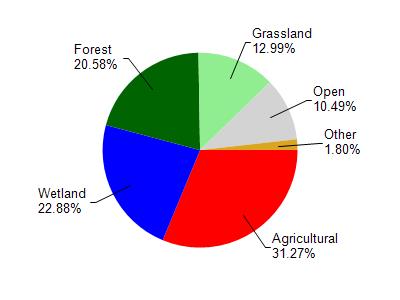Waushara, Winnebago
No
No
No
Fish and Aquatic Life
Overview
Alder Creek is a 14-mile-long tributary to Lake Poygan. With headwaters in Waushara County, it flows south and east into Winnebago County. Rubble and gravel constitute the stream bed, with silt predominating due to heavy upstream streambank erosion. There is a dense growth of arrowhead, reed canary grass and other aquatic vegetation. The fishery is comprised of forage species and crayfish. The lower portion of Alder Creek is affected by Lake Poygan.
From: Bougie, Cheryl A., Kosmond, Lisa D, and Watermolen, Dreux J. 1996. Wolf River Basin Water Quality Management Plan. Wisconsin Department of Natural Resources, Madison, WI.
Date 1996
Author Cheryl Bougie
Historical Description
Alder Creek, T20N, R14E, Section 29 (16), Area = 2.9 acres, Length = 4.0 miles, Gradient = 2.6 feet/mile.
Alder Creek is a turbid , hard water stream draining into Lake Poygan. Silt is the predominant
bottom material along with traces of rubble and gravel. Stream banks are largely
pastured and in places heavily eroded. Growths of arrowhead, reed canary grass,
and other aquatic vegetation are quite dense. During the summer of 1971 water levels in
this stream were very low. The fishery consists only of forage species. Crayfish are common.
Public access is provided by one county highway and one town road.
From: Surface Water Resources of Winnebago County: Lake and Stream Classification Project.
Wisconsin Department of Natural Resources, Madison, WI.
Date 1975
Author Surface Water Inventory Of Wisconsin
Condition
Wisconsin has over 84,000 miles of streams, 15,000 lakes and milllions of acres of wetlands. Assessing the condition of this vast amount of water is challenging. The state's water monitoring program uses a media-based, cross-program approach to analyze water condition. An updated monitoring strategy (2015-2020) is now available. Compliance with Clean Water Act fishable, swimmable standards are located in the Executive Summary of Water Condition in 2018. See also the 'monitoring and projects' tab.
Reports
Management Goals
Wisconsin's Water Quality Standards provide qualitative and quantitative goals for waters that are protective of Fishable, Swimmable conditions [Learn more]. Waters that do not meet water quality standards are considered impaired and restoration actions are planned and carried out until the water is once again fishable and swimmable
Management goals can include creation or implementation of a Total Maximum Daily Load analysis, a Nine Key Element Plan, or other restoration work, education and outreach and more. If specific recommendations exist for this water, they will be displayed below online.
Monitoring
Monitoring the condition of a river, stream, or lake includes gathering physical, chemical, biological, and habitat data. Comprehensive studies often gather all these parameters in great detail, while lighter assessment events will involve sampling physical, chemical and biological data such as macroinvertebrates. Aquatic macroinvertebrates and fish communities integrate watershed or catchment condition, providing great insight into overall ecosystem health. Chemical and habitat parameters tell researchers more about human induced problems including contaminated runoff, point source dischargers, or habitat issues that foster or limit the potential of aquatic communities to thrive in a given area. Wisconsin's Water Monitoring Strategy was recenty updated.
Grants and Management Projects
Monitoring Projects
| WBIC | Official Waterbody Name | Station ID | Station Name | Earliest Fieldwork Date | Latest Fieldwork Date | View Station | View Data |
|---|
| 243100 | Alder Creek | 10017266 | Alder Creek-Cth I-100 Ft below Rd | 5/5/1980 | 11/6/1980 | Map | Data |
| 243100 | Alder Creek | 10022024 | Alder Creek US Apache Rd. | 1/1/2015 | 10/9/2015 | Map | Data |
| 243100 | Alder Creek | 713294 | Alder Creek at Cth H | 5/5/1980 | 8/20/1997 | Map | Data |
|

Watershed Characteristics
Alder Creek is located in the Walla Walla and Alder Creeks watershed which is 112.09 mi². Land use in the watershed is primarily agricultural (31.30%), wetland (22.90%) and a mix of forest (20.60%) and other uses (25.30%). This watershed has 172.60 stream miles, 7,232.18 lake acres and 16,571.69 wetland acres.
Nonpoint Source Characteristics
This watershed is ranked High for runoff impacts on streams, High for runoff impacts on lakes and High for runoff impacts on groundwater and therefore has an overall rank of High. This value can be used in ranking the watershed or individual waterbodies for grant funding under state and county programs.However, all waters are affected by diffuse pollutant sources regardless of initial water quality. Applications for specific runoff projects under state or county grant programs may be pursued. For more information, go to surface water program grants.